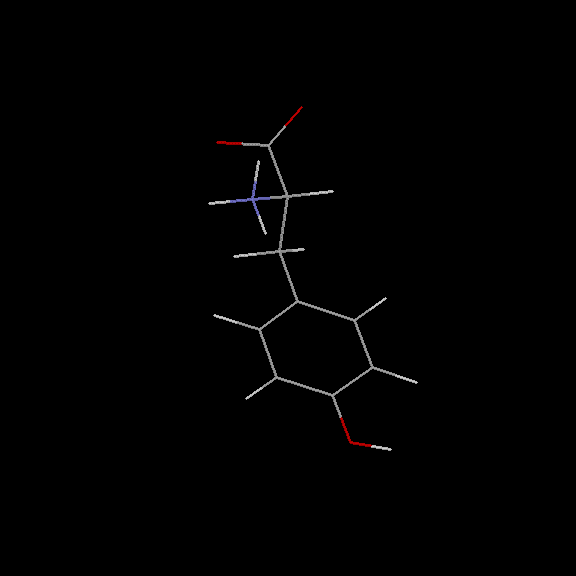L-tyrosine
Tyrosine: Crucial Role in Neurotransmitter Synthesis and Hormonal Regulation
Tyrosine, an α-amino acid represented by the IUPAC-IUBMB abbreviation Tyr and codified on mRNA by the UAU and UAC codons, plays a significant role as a foundational component in the proteinogenic amino acid set. Not considered an essential amino acid for mammals, it can, however, be inadequately produced by the body in specific instances, necessitating dietary supplementation.
The distinctive feature of tyrosine lies in its lateral chain, which comprises a phenol group with a slightly acidic hydroxyl (pKa = 9.767). This property enables it to contribute actively to the synthesis of various essential neurotransmitters, including adrenaline, noradrenaline, dopamine, and DOPA, regulating critical physiological functions related to mood, stress response, and cognitive function.
Furthermore, tyrosine serves as a crucial precursor for the synthesis of melanin, the pigment responsible for the coloration of the skin, hair, and iris. Its role in the formation of thyroid hormones is equally significant, as it acts as a building block for the creation of thyronine from two tyrosine molecules, thereby influencing critical processes related to metabolic regulation and growth.
Recent research has shed light on the intricate interplay of tyrosine in various physiological pathways, underlining its critical role in supporting overall human health and well-being. The multifaceted nature of its contributions makes it a subject of continued interest in the context of various therapeutic interventions and dietary considerations aimed at optimizing human health.
Accession Number : KLM0000391 This work is released into the public domain; please see our release statement.
Doug Markham has contributed a molecular mechanics computation of the structure! See below for the details.

Synonyms :
- L-TYROSINE
- Tyr
- Y
Config Rule :
config('L-tyrosine',[
substituent(aminoacid_L_backbone),
substituent(methandiylphenol),
linkage(from(aminoacid_L_backbone,car(1)),
to(methandiylphenol,car(1)),
down,single)]).
%%%% Substituent Config Rules for compound 'L-tyrosine' %%%%
config(aminoacid_L_backbone,[
left(amino),
right(hyd),
top(carboxyl),
center(car(1))]).
config(methandiylphenol,[
substituent(methandiyl),
substituent('phenol-1-yl'),
linkage(from(methandiyl,car(1)),
to('phenol-1-yl',car(1)),
nil,single)]).
%%%% Substituent Config Rules for compound methandiylphenol %%%%
config('phenol-1-yl',[
ring([
car(1)&,
car(2,hyd)&,
car(3,hyd)&,
car(4,hydroxyl)&,
car(5,hyd)&,
car(6,hyd)&])]).
Smiles String :
[C@2H]([NH3+])([C](=[O])[O-])[C@2H2]-[c]1([cH][cH][c]([cH][cH]1)[OH]) 'L-tyrosine'
Terminal :
% 'L-tyrosine'
c(1,12,(0,chiral))-[n(1,left)~,h(1,right)~,c(2,up)~,c(3,down)~],
c(2,12,(0,nonchiral))-[o(1,nil)?,o(2,nil)?,c(1,down)~],
c(3,12,(0,nonchiral))-[c(4,left)~,h(5,right)~,c(1,up)~,h(6,down)~],
c(4,12,(0,nonchiral))-[c(3,right)~,c(9,flat)&,c(5,flat)&],
c(5,12,(0,nonchiral))-[h(7,nil)~,c(4,flat)&,c(6,flat)&],
c(6,12,(0,nonchiral))-[h(8,nil)~,c(5,flat)&,c(7,flat)&],
c(7,12,(0,nonchiral))-[o(3,nil)~,c(6,flat)&,c(8,flat)&],
c(8,12,(0,nonchiral))-[h(10,nil)~,c(7,flat)&,c(9,flat)&],
c(9,12,(0,nonchiral))-[h(11,nil)~,c(8,flat)&,c(4,flat)&],
h(1,1,(0,nonchiral))-[c(1,left)~],
h(2,1,(0,nonchiral))-[n(1,right)~],
h(3,1,(0,nonchiral))-[n(1,down)~],
h(4,1,(0,nonchiral))-[n(1,up)~],
h(5,1,(0,nonchiral))-[c(3,left)~],
h(6,1,(0,nonchiral))-[c(3,up)~],
h(7,1,(0,nonchiral))-[c(5,nil)~],
h(8,1,(0,nonchiral))-[c(6,nil)~],
h(9,1,(0,nonchiral))-[o(3,nil)~],
h(10,1,(0,nonchiral))-[c(8,nil)~],
h(11,1,(0,nonchiral))-[c(9,nil)~],
n(1,14,(1,nonchiral))-[h(2,left)~,c(1,right)~,h(3,up)~,h(4,down)~],
o(1,16,(-5.0E-01,nonchiral))-[c(2,nil)?],
o(2,16,(-5.0E-01,nonchiral))-[c(2,nil)?],
o(3,16,(0,nonchiral))-[h(9,nil)~,c(7,nil)~]
The Terminals for all the Config Rules are in Prolog Definite Clause Grammar (DCG) form.They can be checked in the Manual here.
The compound's PDB file can be seen here.
Doug Markham of the Institute for Cancer Research, Fox Chase Cancer Center,Philadelphia, PA, has contributed the following structure for L-tyrosine. He computed this structure in sdf format using MacroModel, a molecular mechanics program. We have used Babel to convert the .sdf format to PDB format. You'll find it interesting to compare these structures to those computed using CONCORD.
Many thanks Doug!
